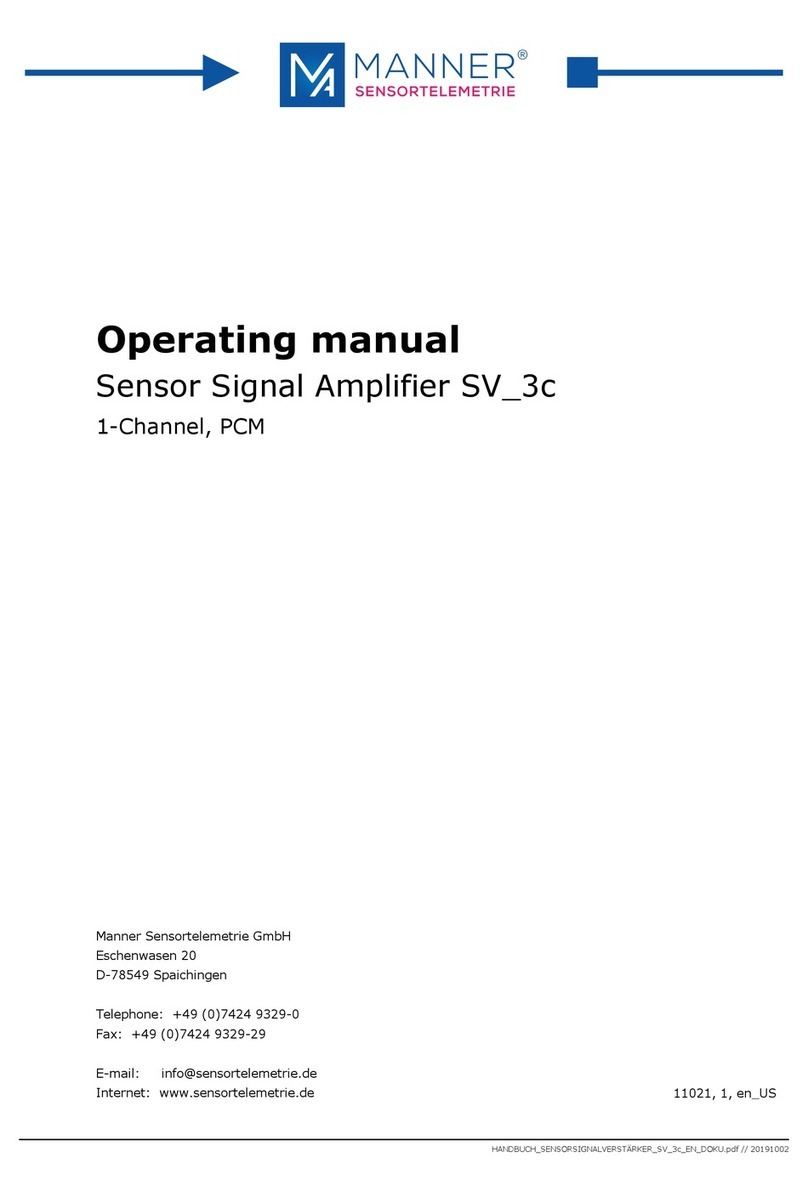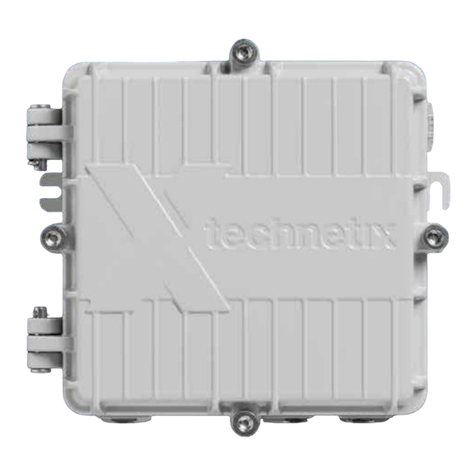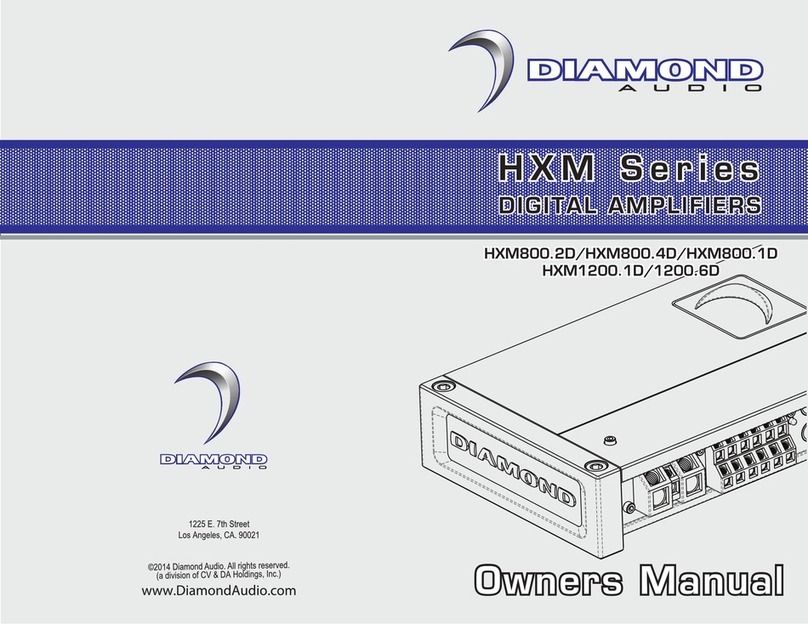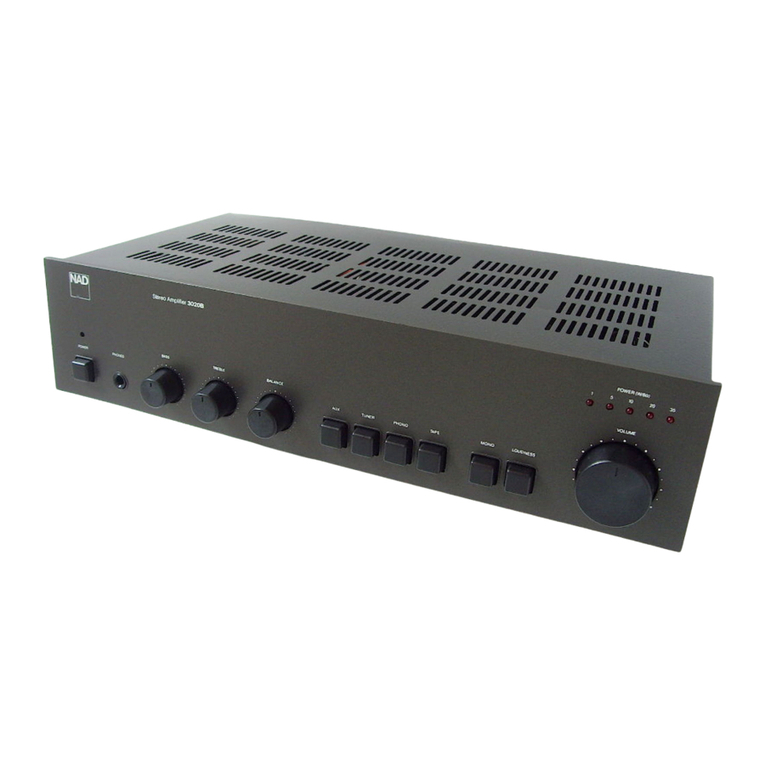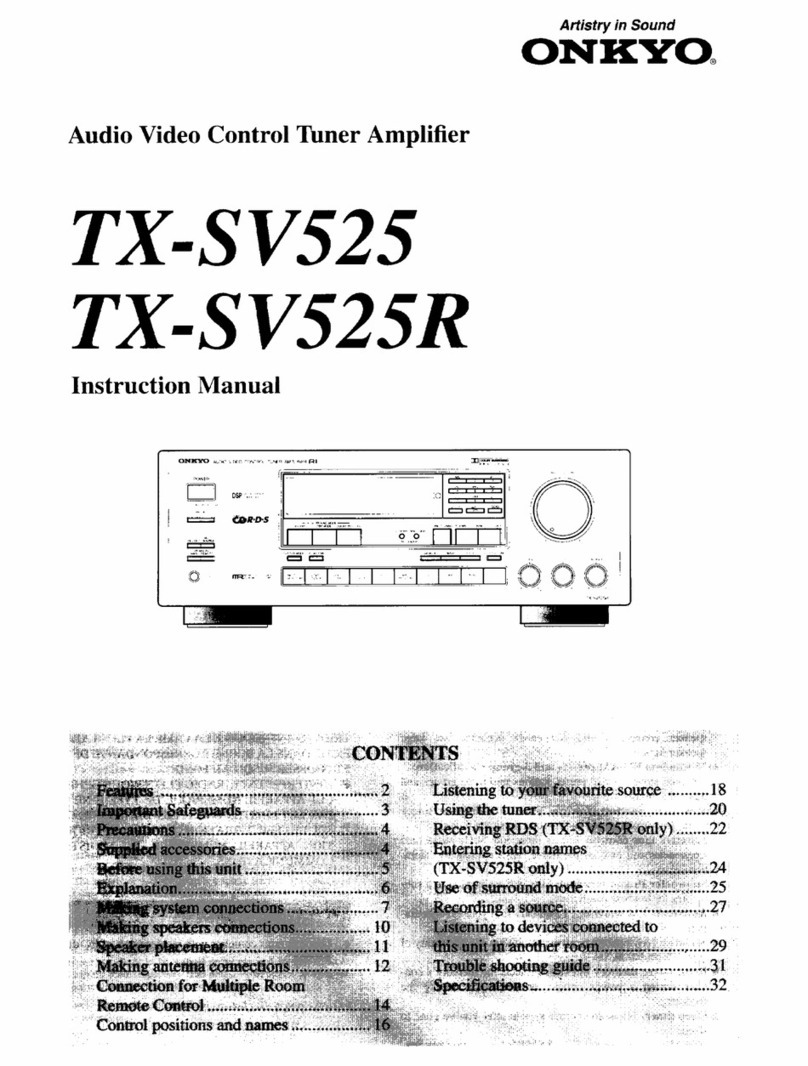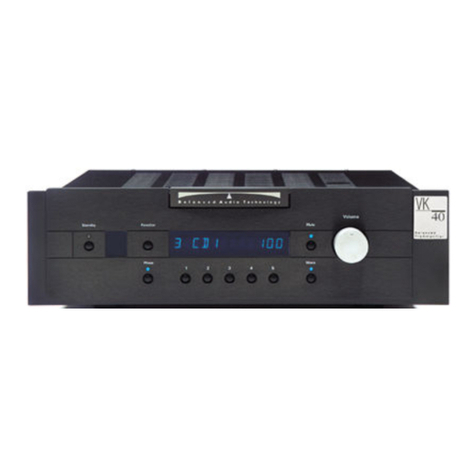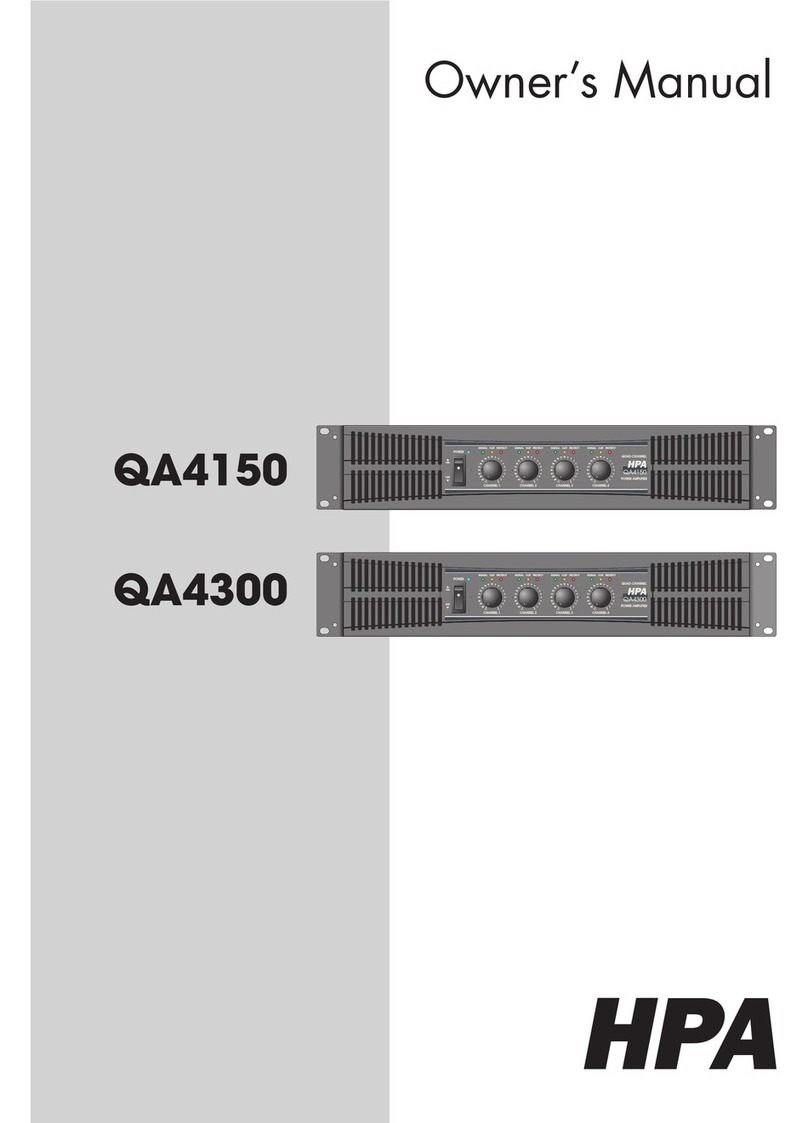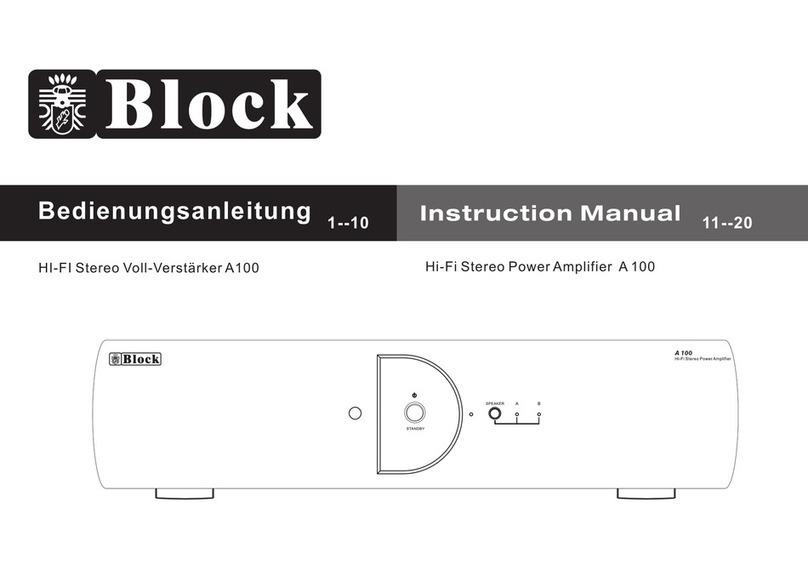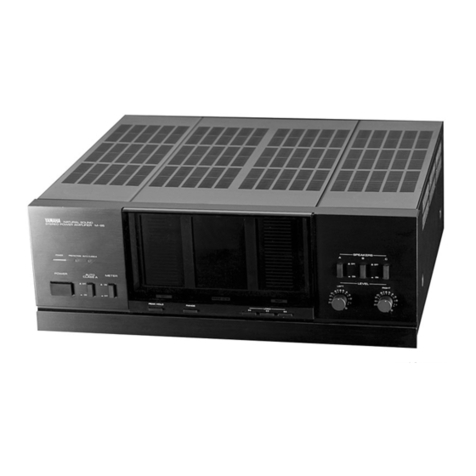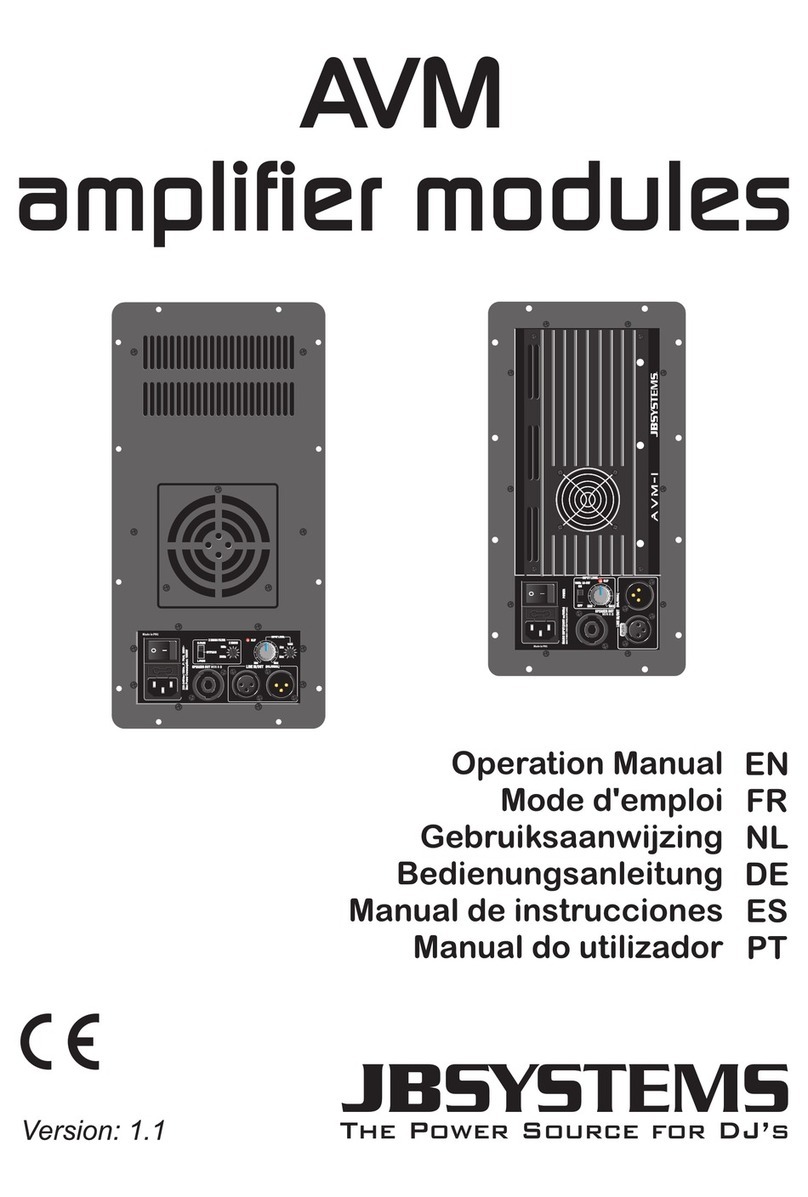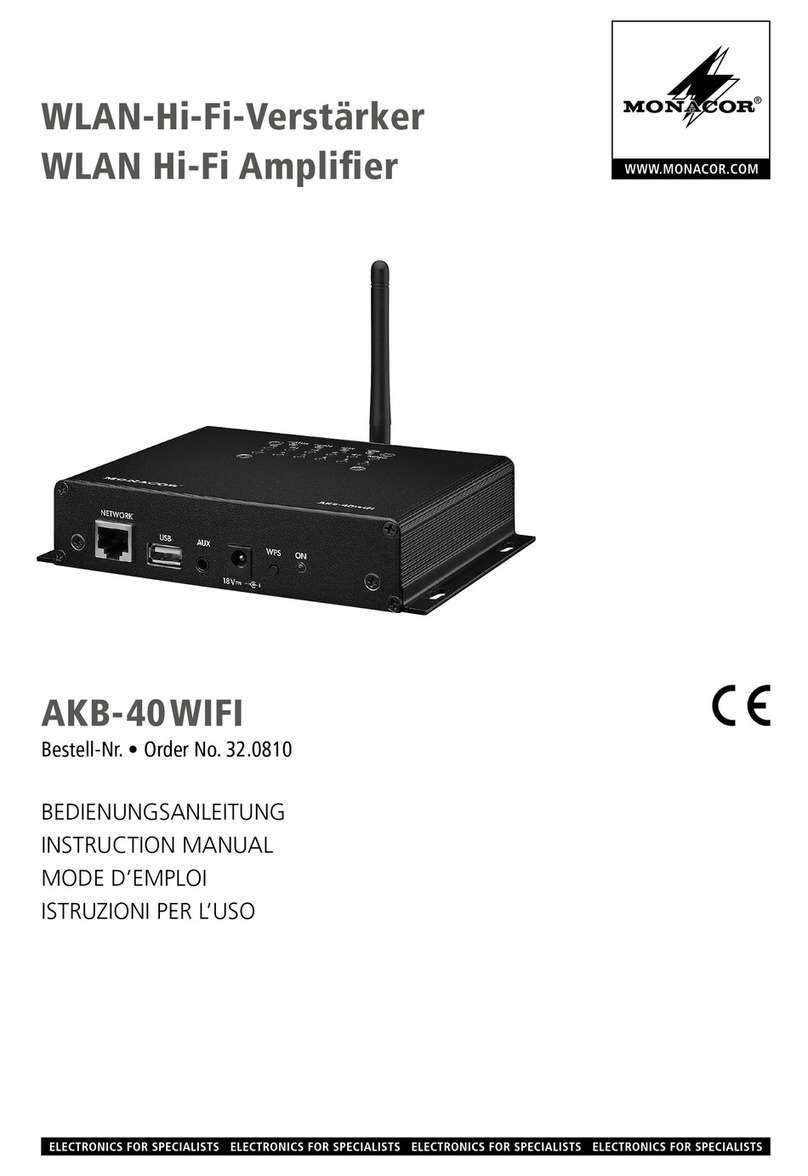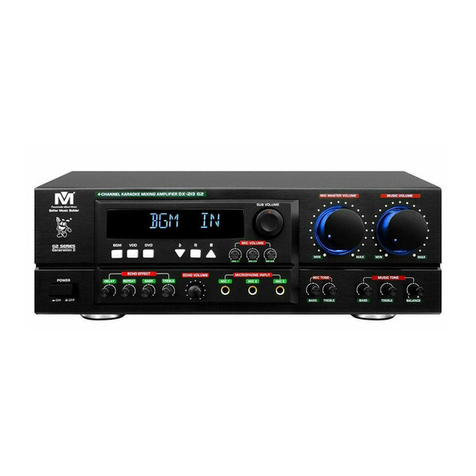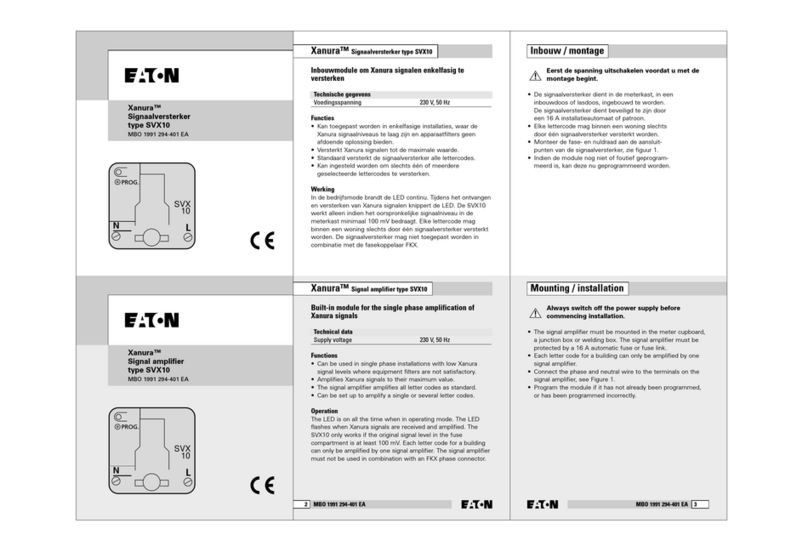Manner SV 4b Series User manual

1-Channel, PCM
Sensor Signal Amplifier SV_4b
Operating manual
11010, 1, en_US
Manner Sensortelemetrie GmbH
Eschenwasen 20
D-78549 Spaichingen
Telephone: +49 (0)7424 9329-0
Fax: +49 (0)7424 9329-29
E-mail: [email protected]
Internet: www.sensortelemetrie.de
HANDBUCH_SENSORSIGNALVERSTÄRKER_SV_4b_EN_DOKU.pdf // 20190916

Document code Date Modification Approval
11010, 1, en_US 2019-09-16 Creation of documentation 2019-09-16, von Borcke
All rights for duplicating, photomechanical reproduction – also extracts - are explic-
itly reserved by the enterprise Manner Sensortelemetrie. Trade marks and trade
names were used without verification of the free applicability.
The texts and examples were prepared with care. Mistakes can not be excluded. The
enterprise Manner Sensortelemetrie will assume no liability for missing or incorrect
information and resulting consequences, neither judicial nor otherwise.
The enterprise Manner Sensortelemetrie GmbH may change or upgrade hardware
and software – or parts of them - as well as the provided documents (operation
instructions, start-up instructions, spare parts lists) – or parts of them – without
notification.
We would be pleased for suggestion for improvement and notes about mistakes.
©September 2019, Manner Sensortelemetrie GmbH
Revision History:
Copyright
Disclaimer Documentation
Modifications
2 11010, 1, en_US

Table of contents
1Safety............................................................................................... 4
1.1 Definition of Warnings................................................................... 4
1.2 General Warnings......................................................................... 4
2 Conventional Usage........................................................................... 6
3Technical Data.................................................................................. 7
3.1 Measuring System......................................................................... 7
3.2 Sensor Signal Amplifier, Sensors..................................................... 8
3.2.1 Gain Bandwidth Characteristic...................................................... 9
3.2.2 Operation Mode Strain Gauge Bridge........................................... 10
3.2.3 Remote Shunt Calibration Function............................................. 11
3.2.4 List for Shunt Calibration Resistor............................................... 12
3.2.5 Operation Mode PT100.............................................................. 13
4 Mounting / Starting......................................................................... 14
4.1 Connection between Sensor Signal Amplifier and Rotor Antenna........ 14
4.2 Coupling / Installation.................................................................. 15
4.3 Test Circuit................................................................................. 17
5 Options........................................................................................... 18
6Maintenance.................................................................................... 19
7 Contact........................................................................................... 20
11010, 1, en_US 3

1 Safety
1.1 Definition of Warnings
DANGER!
Hint for possible dangerous situation. Ignoring the security terms
may cause death or serious injury.
WARNING!
Hint for possible dangerous situation.
Ignoring the security terms may cause injury.
CAUTION!
Hint for possible damage of property, if the corresponding protec-
tive measure were disregarded.
Further information
1.2 General Warnings
The system startup has to be carried out by trained qualified personnel, who is able
to evaluate the potential risks. All chapters of this instruction manual had to be read
and fully understood before startup.
On non-observance it’s not possible to assert a claim for the incurred losses from
the manufacturer. Any changes to the system, except those described in the
instruction manual and customer documentation, will invalidate any warranty.
DANGER!
Risk of Injury by Incorrect Installation
Incorrect installation can cause injury to persons directly while the
installation or during the subsequent startup
Note the Mounting Hint (see chapter 4, installation
instruction)
The system startup has to be carried out by instructed qualified
personnel that’s familiar with
– the professional handling of security relevant components,
–the valid regulations for operational safety und rules for acci-
dent prevention.
DANGER!
Risk of Injury by Unintentional Startup
Rotating or moving of parts by inadvertent startup of the machine
can cause injury .
During all mounting, demounting or repairing the system has to be
powered-off. Note the mounting instructions.
4 11010, 1, en_US

DANGER!
Risk of Injury by Movable Parts
While normal operation, as well as inadvertent loosening of parts
of the telemetry system during operation, present persons may be
injured if protective equipment is absent.
Check the safety function of the protective equipment particularly
– before each startup
–after each replacement of a component
– after a longer standstill
– after each defect
Independent thereof the safety function of the protective equip-
ment must be checked in suitable time intervals as part of the
maintenance work!
WARNING!
Risk of Burn Injury
While operation the sensor signal amplifier and the stator antenna
may become warm.
Avoid contact.
CAUTION!
Risk of Property Damage
If the connectors disconnected / connected while the
system is powered on the telemetry system as well as the
connected devices can be damaged.
Plug connectors must not be disconnected / connected
when the system is powered on.
11010, 1, en_US 5

2 Conventional Usage
Sensor telemetry systems are used for contact-free data and power transfer from
passive and active sensors (e.g. on rotating shafts).
DANGER!
Risk of Subsequent Damages caused by Malfunctions
If the telemetry system is used for controlling or regulating func-
tions it is not conceive for, subsequent damages up to injury to
persons can be caused.
The delivered system has to be used exclusively used for
the purpose for which it was ordered.
The operator must take care of his health and safety.
The operator of the equipment must prevent subsequent errors
following faulty measuring results. This is particularly necessary if
the telemetry system is used in controlling or regulating functions.
The customer, as the builder of a system with an integrated sensor tele-
metry system, is responsible for the correct and conform operation and also
assumes the responsibility for ensuring that the system at start-up com-
plies with all provisions of Directives 2014/53/EU and 2014/35/EU.
A telemetry system normally contains:
nEvaluation unit
nStator antenna
nRotor antenna
nSensor signal amplifier
nHF cable
For the detailed purchased parts package of the delivered tele-
metry system mind the corresponding shipping ticket.
Scope of Delivery
6 11010, 1, en_US

3 Technical Data
3.1 Measuring System
Term Value
HF frequency 13.56 MHz
Number of channels 1
Bandwidth 0 to 1 kHz (-3dB)
Linearity <0.1%
Fig. 1: General measuring configuration
Fig. 2: Block diagram
Fig. 3: Energy and data flow
Technical Data Telemetry
System
General Measuring
Configuration
Block Diagram
Energy and Data Flow
11010, 1, en_US 7

3.2 Sensor Signal Amplifier, Sensors
Term Value
Sensor signal amplifier type SV_4b_PCM16
Sensor Strain gauge
(strain gauge resistor ³350 W),
PT100
Type of modulation PCM
HF frequency 13.56 MHz
Channel sample rate 6.62 kS/s
Bridge supply voltage [UB] 3.3 V
Coarse voltage [Ucoarse_max] 6.4 to 7.2 V
Zeropoint and gain drift 0.02% / °C
Linearity 0.1% typ.
Amplification (adjustable by solder
resistor) 0.05 to 20 mV/V
Bandwidth 0 to 1 kHz
Resolution 16 Bit with 16 Bit CRC
Protection class IP42
Temperature range -10 to +85°C
Fig. 4: SV_4b_PCM16, mechanic
Technical Data Sensor Signal
Amplifier
Scale Drawing Sensor Signal
Amplifier
8 11010, 1, en_US

NOTICE!
Possible Damage to the Rotor Electronics while soldering
A soldering that is too long or too hot can damage the sensor
signal amplifier. Keep soldering as short as possible. If necessary,
allow to cool.
NOTICE!
Damaging of Electronic
Condensation may cause unwanted contact between the pins
To prevent any effects of condensation the pin connections must
be waterproofed!
The housing is internally connected to GND.
The sensor signal amplifier must be grounded to the rotor, e.g. by
screw and toothed washer or by connecting the GND- pin to the
rotor.
Fig. 5: SV_4b_PCM16, Pin assignment
3.2.1 Gain Bandwidth Characteristic
The output signal bandwidth ranges from 0 to 1 kHz.
Pin Assignment Sensor Signal
Amplifier
Gain Bandwidth Characteristic
Fig. 6: Gain bandwidth
characteristic
11010, 1, en_US 9

3.2.2 Operation Mode Strain Gauge Bridge
Fig. 7: Operation mode strain gauge (full bridge)
Resistor Rv [kW] Sensitivity [mV/V]
24.8 4
12.4 2
6.2 1
3.1 0.5
1.55 0.25
0.775 0.125
Fig. 8: Operation mode strain gauge (half bridge)
Additional resistors RAdd = 1 kW, 0.1 %, Tk 15
Operation Mode Strain Gauge
(Full Bridge)
Operation Mode Strain Gauge
(Half Bridge)
10 11010, 1, en_US

Fig. 9: Operation mode strain gauge (quarter bridge)
Additional resistors RAdd = 1 kW, 0.1 %, Tk 15
3.2.3 Remote Shunt Calibration Function
Fig. 10: Remote shunt calibration function
RCal see "List for Shunt Calibration Resistor"
Operation Mode Strain Gauge
(Quarter Bridge)
11010, 1, en_US 11

3.2.4 List for Shunt Calibration Resistor
E = dL * kFactor
Rshunt = 1 / (-1+ 1 / (-1+1 / (0.5+E / 1000))) * Rstrain = (500-E) / (2*E) * Rstrain
The system is based on a 350 W full strain gauge bridge !!!
Note:
When using a half strain gauge bridge the same mechanical expansion [dL] results in a half of the electrical signal [E]
shown in the table above.
e.g. dL = 487.8049 mm/m ® E = 0.5 mV/V ® RShunt = 174.84 kW ...
When using a quarter strain gauge bridge the same mechanical expansion [dL] results in a quarter of the electrical
signal [E] shown in the table above.
e.g. dL = 487.8049 mm/m ® E = 0.25 mV/V ®RShunt 349.83 kW ...
12 11010, 1, en_US

Usage of a strain gauge bridge resistor deviating from the standard resistor
Deviation of sensor signal gain [mV/V] when using strain gauge bridge resistor
other than 350 W.
Applied bridge resistor
Rstrain gauge [W]
fullbridge
Deviation of the sensor signal gain
to the reference value
Rstrain gauge = 350 W
fullbridge
120 +1.0%
350 0.0%
700 -1.8%
1,000 -3.1%
1,400 -5.0%
2,000 -7.5%
3,000 -11.5%
4,400 -16.6%
5,000 -18.6%
3.2.5 Operation Mode PT100
Fig. 11: Operation mode PT100
Resistor Rv
kW
Temperature
°C
72 500
36 250
18 125
8 62.5
11010, 1, en_US 13

4 Mounting / Starting
4.1 Connection between Sensor Signal Amplifier and Rotor Antenna
Leads tight twisted; as short as possible, max. 30 cm
Shaft diameter <150 mm: Connect the antenna loop with HF GND and HF1
Shaft diameter >150 mm: Connect the antenna loop with HF1 and HF2
Fig. 12: Connection of rotor antenna
14 11010, 1, en_US

4.2 Coupling / Installation
DANGER!
Risk of Faulty Measuring Data and Resulting Subsequent
Errors, up to Injury to Persons
Damaging, modifications or disturbance of the coaxial cable(s)
may falsify the measuring results and optionally cause subsequent
errors according to operation purpose.
Do not buckle the coaxial cable!
Do not modify the coaxial cable!
Do not keep data cable and the coaxial cable together with
energy- / high-power current cables!
The connectors of the HF energy and / or HF data coaxial cable
must not have connection to the grounding of the machine!
Permissible bending radii for coaxial cables:
– RG58 ® RB = 25 mm
– RG400 ® RB = 30 mm static / 50 mm dynamic
– RG178 ® RB = 15 mm
– RG213 ® RB = 50 mm
– RG316 ® RB = 15 mm
The bending radii of the used coaxial cables must not be undercut
CAUTION!
Damaging of Antenna System
Contact between rotor antenna and stator antenna while operating
may cause mechanical damages of the antennas
The stator antenna must not touch the rotor antenna.
CAUTION!
Risk of Damaging of Electronic, Faulty Measuring Data
While overheating of the evaluation unit the built-in electronics
may be damaged
An overheated evaluation unit may cause faulty measuring values
and respectively subsequent errors
The evaluation unit must be mounted onto a heat conductive base.
CAUTION!
Damaging of Evaluation Unit Caused by High Vibrancy
High Vibrancy of the evaluation unit may cause damaging
While mounting in environments with high vibrancy (e.g. in vehi-
cles) the evaluation unit must be mounted vibration damped, e.g.
by rubber buffer.
The stator antenna must be mounted directly opposite to the rotor
antenna
The stator antenna must be mounted in the middle of the moving
range of the rotor antenna
Antenna Coupling
11010, 1, en_US 15

Fig. 13: Coupling
DANGER!
Risk of Injury
Incorrect installation can cause injury to persons directly while the
installation or during the subsequent startup
Follow mandatory the rules for accident prevention!
1. Mount the sensor signal amplifier with rotor antenna
2. Position the stator antenna correct to the rotor antenna
3. Connect the stator antenna with the evaluation unit
4. Switch the system on
5. Release the measuring position complete
6. Adjust the output signal to 0.000 V by using the screw ‘0’
7. Load the measuring position with nominal load or set the Cal.signal perma-
nently
8. Adjust the output signal to +10.000 V by using the screw 'G' and measuring
the "Analog output signal' or adjust to the value noted in the calibration pro-
tocol.
9. Release the measuring position complete or remove Cal.signal
10. Check the output signal to zero. Repeat step 5 to 10, if necessary.
Startup
16 11010, 1, en_US

4.3 Test Circuit
Fig. 14: Test circuit
Operation mode strain gauge
sensor (full bridge)
11010, 1, en_US 17

5 Options
nTemperature measurement (PT100, Thermocouple)
nRemote Control
nwaterproof
nATF oilproof
If you have any questions regarding customer-specific solutions,
please contact our sales department.
Optionally available
18 11010, 1, en_US

6 Maintenance
The systems of Manner Sensortelemetrie are low-maintenance.
DANGER!
Risk of Injury Caused by Defects on System Built-Up
Particularly loose or damaged parts may endanger present persons
Carry out the maintenance regularly and assiduously.
Within a periodical repeating maintenance following operations have to be
done:
nClean the antenna system, vacuuming of dust deposit
nCheck the antenna system for scrub marks or mechanical damages
nCheck the fastening of the stator antenna for a fix seat and tighten of the
screwed fastenings where necessary.
nCheck the plug connections and cables
Document the completed annual maintenance
11010, 1, en_US 19

7 Contact
MANNER Sensortelemetrie GmbH
Eschenwasen 20
D - 78549 - Spaichingen
Tel.: +49 7424 9329-0
Fax: +49 7424 9329-29
www.sensortelemetrie.de
20 11010, 1, en_US
Table of contents
Other Manner Amplifier manuals
